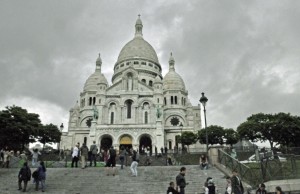It is not unusual for people to attend a church as an act of penance. But the Basilica of Sacre Coeur, a multi-domed cathedral on Montmartre, the highest hill in Paris, turns that tradition on its head. This beautiful church, built in an area notorious for its lack of piety, is itself the penance.
In the early 1800s, artists came to the rural area surrounding Montmartre to paint its picturesque farms and windmills. That area, also called Montmartre, eventually became part of the city and a popular home for artists and philosophers, famous for its Bohemian lifestyle. Toulouse-Lautrec, Van Gogh and Picasso all found inspiration in Montmartre and its people.
In 1871, with intellectual support from Montmartre’s cafes and clubs, working class Parisians mounted an armed rebellion against the local government and its supporters in the Church. Because of its strategic location, some of the earliest and fiercest fighting took place on Montmartre. In what became known as the “Paris Commune,” insurgents seized control of the city and executed its archbishop. But in only two months, the revolt was crushed by national troops, with unknown thousands of insurgents either killed in battle or summarily executed.
With the rebellion over, the National Assembly, encouraged by Church leaders, decreed that all French citizens atone for the excesses of the Commune and the ideas that had spawned it. Eager to earn God’s forgiveness, the French people came forward with donations sufficient to build a cathedral on Montmartre, in the very heart of the insurrection. Supporters of the revolutionary ideas of the Commune, seeing the cathedral as a political statement, tried to block its construction. But Sacre Coeur, named for the Sacred Heart of Jesus and reminiscent of the Taj Mahal, was started in 1875 and completed in 1914 at a cost of seven million francs. The basilica, visible from all over Paris, can be reached by climbing about 300 steps from an area that even today attracts artists because of the extraordinary views it offers of the city and each other.
The Montmartre area retains much of the free-wheeling character it had in the nineteenth century, with topless bars and adult entertainment drawing tourists from all over the world. The nearby Moulin Rouge still mocks the bucolic origins of its famous windmill. But today, a funicular runs up Montmartre to Sacre Coeur in 90 seconds, making it easy for revelers to seek absolution before leaving for the quieter parts of Paris. The sacred and the profane are rarely closer.
